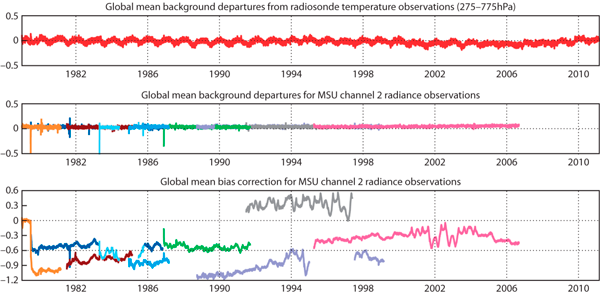

In response to demands from many users, the ERA-Interim reanalysis dataset has been extended by a decade and now includes data from 1 January 1979 to the present. This extension makes the dataset even more useful for climate-related studies and climate change monitoring, as it now covers a period exceeding three decades.
The 10-year extension was completed in just under eight months with few technical interruptions. Most importantly, the accuracy of the reanalysed fields is not very different in the first decade compared to the 1990s, and the temporal consistency of the extended reanalysis is remarkably good. This can be seen, for example, in time series of observation departures, and also in the bias corrections of satellite radiance data that are automatically generated during the reanalysis. Producing a long reanalysis in multiple streams has always been a challenge, but this (unplanned) exercise with ERA-Interim has demonstrated that it is possible to do so without introducing major jumps or shifts in the final product.
ERA-Interim data for 1979–1988 are now available in MARS and on the ECMWF public data server. We will continue to extend the ERA-Interim reanalysis forward in time for several more years, until it can be replaced by a new version that uses an up-to-date IFS release and an improved set of input observations. This will be done in the framework of the ERA-CLIM project (see ECMWF Newsletter 123, p.6); current plans are to begin production of such a new reanalysis of the satellite era by the end of 2012.

The three panels demonstrate the stability and temporal consistency of the extended ERA-Interim reanalysis, and the nearly seamless transition between the two production streams on 1 January 1989. Reanalysed temperatures in the mid-troposphere are largely consistent with radiosonde observations (top panel) and with bias-corrected radiance measurements from Microwave Sounding Units flown on successive NOAA satellites (centre panel; colours indicate different satellites). The bias corrections for the MSU data, produced by the variational analysis in ERA-Interim, account for calibration differences, orbital drifts and various other instrument errors (lower panel).
